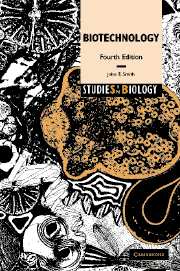Book contents
- Frontmatter
- Contents
- Preface
- 1 The nature of biotechnology
- 2 Substrates for biotechnology
- 3 Genetics and biotechnology
- 4 Bioprocess/fermentation technology
- 5 Enzyme technology
- 6 Biological fuel generation
- 7 Single cell protein (SCP)
- 8 Biotechnology and medicine
- 9 Environmental biotechnology
- 10 Biotechnology in the agricultural and forestry industries
- 11 Food and beverage biotechnology
- 12 Protection of biotechnological inventions
- 13 Safety in biotechnology
- 14 Public perception of biotechnology: genetic engineering – safety, social, moral and ethical considerations
- 15 Looking to the future
- Glossary
- Further reading
- Index
7 - Single cell protein (SCP)
Published online by Cambridge University Press: 05 June 2012
- Frontmatter
- Contents
- Preface
- 1 The nature of biotechnology
- 2 Substrates for biotechnology
- 3 Genetics and biotechnology
- 4 Bioprocess/fermentation technology
- 5 Enzyme technology
- 6 Biological fuel generation
- 7 Single cell protein (SCP)
- 8 Biotechnology and medicine
- 9 Environmental biotechnology
- 10 Biotechnology in the agricultural and forestry industries
- 11 Food and beverage biotechnology
- 12 Protection of biotechnological inventions
- 13 Safety in biotechnology
- 14 Public perception of biotechnology: genetic engineering – safety, social, moral and ethical considerations
- 15 Looking to the future
- Glossary
- Further reading
- Index
Summary
The need for protein
A major challenge to creating a sustainable future for the world's populations will be to secure adequate food supplies for the majority. The number of humans in the world now approximates six billion, and increasing, and could well be over nine billion within the next 25 years (Fig. 7.1). Fortunately, recent statistics suggest that world population growth rate is slowing but, even so, overall numbers are increasing. Patterns of births worldwide indicate that over 90% are occurring in the southern hemisphere, where already 80% of the world's population live, yet they only use 20% of the world's resources.
It is also estimated that, by 2030, urban populations will be at least twice that of rural populations. The growth of urbanisation, together with ensuing environmental degradation, causes serious losses in the availability of productive agricultural land. In many parts of the world, such as Africa, soil fertility is declining and is further exacerbated by increasing water scarcity in the southern hemisphere. Furthermore, worldwide climate changes and increasing civil strifes continue to make accurate predictions of future food supplies unpredictable.
It is becoming increasingly documented that conventional agriculture will struggle to supply sufficient food, in particular protein, to satisfy a growing world population.
However, productivity is increasing throughout the world in all branches of agriculture. Biotechnological innovations will accelerate this trend (Chapter 10). Food surpluses are occurring in many places, particularly in North America and western Europe, where there are near static populations.
- Type
- Chapter
- Information
- Biotechnology , pp. 118 - 135Publisher: Cambridge University PressPrint publication year: 2004



